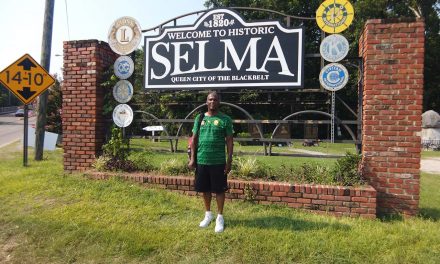
“The Negro in Birmingham, like the Negro elsewhere in this nation, had been skillfully brainwashed to the point where he had accepted the white man’s theory that he, as a Negro, was inferior. He wanted to believe that he was the equal of any man; but he didn’t know where to begin or how to resist the influences that had conditioned him to take the line of least resistance and go along with the white man’s views. He knew that there were exceptions to the white man’s evaluation: a Ralph Bunche, a Jackie Robinson, a Marian Anderson. But to the Negro, in Birmingham and in the nation, the exception did not prove the rule…In Montgomery, during the bus boycott, and in the Albany, Georgia, campaign, we had had the advantage of a sympathetic and understanding national press from the outset. In Birmingham we did not…They did not know we had postponed our campaign twice…Above all they did not realize that it was ridiculous to speak of timing when the clock of history showed that the Negro had already suffered one hundred years of delay.” – Rev. Dr. Martin Luther King Jr. book “Why We Can’t Wait” (1964)
How much patience can the Black community muster in its’ fight to gain a measure of respect in America? The historical record shows very clearly that we have advocated and fought for freedom, justice and liberty for so long that the words sometimes feel empty.
From the first Africans back in West Africa fighting to break their chains in the dungeons they were held in as their European captors waited to send them to work for free in the Americas, the battle has been never ending. We had to fight the Africans who sold us when the Europeans gave them guns to defeat and sell their neighbors. We had to fight what became an international theft of Africans who were transported to the east and west. Africans were sold in Asia, the Middle East, and the Americas as well as throughout the Caribbean basin.
Most Americans have no idea how widespread the enslavement of Africans was in the western hemisphere. Estimates are that about 40 percent of all Africans transported into bondage in this part of the world where shipped to Brazil. That nation has a larger African ancestored population (91 million in 2010) than all but four countries in Africa. In Sub-Saharan Africa, which is where most of the Africans were stolen from, only Nigeria (206 million) and the Democratic Republic of the Congo (103 million) have a larger African ancestored population. Most people would automatically assume that this distinction would belong to the United States (44 million).
In 1968 Joanne Grant attempted to document the history of Blacks articulating their desire for freedom. Her book, Black Protest: 350 Years of History, Documents, and Analyses is a brilliant piece of research and scholarship.
“…the history of the black man’s protest against enslavement, subordination, cruelty, inhumanity began with his seizure in African ports and has not yet ended.”
During our journey many who’ve protested have articulated very different ways of gaining our freedom. Some preferred armed rebellion, as the hundreds of documented “slave revolts” and “slave ship mutinies” gives us evidence of. Some have advocated for abolition of slavery, many years before and much more forcefully, than the White people we are taught about as America’s abolitionists. Some have worked tirelessly in courts, forcing the U.S. government and state governments to live up to the ideals in the Constitution.
These battles began early in the history of our forced migration out of Africa. Historian Harvey Wish writes about mutinies onboard these horrible slaving ships.
“The insurrection itself was a desperate struggle waged with the courage of despair. Sometimes weapons would reach the slaves through the female captives who were frequently given comparative freedom on the deck. Naturally, in the greater number of cases, the revolt was doomed to failure, and the retribution was swift and terrible. Every refinement of torture was utilized by the captain, and the ring leaders, at least were killed. Captain Harding, for example, borrowed the methods of savagery by compelling the rebels to eat the heart and liver of a sailor who had been killed, and hanged a woman leader by her thumbs, whipping and slashing her with knives.”
Despite this savagery by so-called civilized Europeans from the United Kingdom, France, Spain, Portugal, Holland and many other nations, the Africans were exceptionally resilient and most endured and survived the journey on roach and rat-infested ships during the Middle Passage. Dr. Joy DeGruy calls Black people a “miracle.” To have survived and still be around after four hundred and one years of this treatment proves that we have an abundance of strength and resiliency.
As the Founding Fathers were meeting to plot their separation from King George, their new nation was holding over 600,000 Africans in bondage. As the Declaration of Independence was declaring “all men are created equal,” apparently Africans were not seen as part of the human family.
In Boston, on April 20, 1773 a group of enslaved Blacks petitioned the state legislature for their freedom. By asking for gradual emancipation, they showed a clear understanding of the difficulty of expecting immediate freedom.
“…as the people of this province seem to be actuated by the principles of equity and justice, we cannot but expect your house will again take our deplorable case into consideration, and give us that ample relief from, as men we have a natural right to.”
They went on to say that they were willing to leave America and return to Africa if granted their freedom. Of course this request, written with the most humble and respectful language possible, fell on deaf ears. All of the original thirteen colonies had slavery laws on the books, in fact they practiced slavery significantly longer than the states we typically associate with slavery: New Jersey (201 years); Connecticut (198 years); New York (163 years); Pennsylvania (145 years); New Hampshire (143 years); Rhode Island (142 years); Massachusetts (139 years) as compared to Alabama (46 years); Mississippi (48 years); Louisiana (53 years); and Tennessee (69 years).
When five of the seven northern states ended slavery they wrote “gradual emancipation” laws. The constitutions of Vermont (1777) and Massachusetts (1783) forbade slavery and freed the enslaved people within their states immediately. In 1780 Pennsylvania decreed by law that:
“Be it enacted, and it is hereby enacted, That all persons as well Negroes and Mulattoes as others, who shall be born within this state from and after the passing of this act, shall not be deemed and considered as servants for life, or slaves; and that all servitude for life, or slavery of children, in consequence of the slavery of their mothers, in the case of all children born within this state from and after the passing of this act as aforesaid, shall be, and hereby is, utterly taken away, extinguished, and for ever abolished.”
That is the part that is in the history book. This part is not: “until such child shall attain unto the age of twenty-eight years.” The General Assembly passed the bill with a 34 to 21 vote. I find it instructive that they said, “all persons as well Negroes and Mulattoes as others” making it clear that Blacks were not considered persons.
Connecticut followed a similar pattern in 1784. Connecticut “freed children born to enslaved women after March 1, 1784. It did not free the mother, the father, or any other adults. Neither did the children gain their full freedom until they reached, for men, age 25, and for women, age 21” according to connecticuthistory.org.
Rhode Island joined Connecticut passing “gradual abolition in 1784 as well. Fifteen years later New York issued gradual emancipation stating that all children born into slavery after July 4, 1799 in the state would be free when they turned 25 (for women) or 28 (for men). In 1817, a second law stipulated that those still enslaved in the state who were born prior to July 4, 1799, would be free on July 4, 1827. It took twenty eight years to end slavery in New York even though the history books often state slavery ended there with the passage of the 1799 law.
In 1804 New Jersey’s gradual emancipation law stated that females would be enslaved until they were twenty-one years old and males until twenty-five years old made them the last northern state to end slavery.
Along our path in American history, some of the greatest movements toward freedom came from Black people. In fact, many of the movements such as abolitionism and woman’s suffrage were fought for by Blacks before Whites jumped on the bandwagon.
Post-Civil War and Post-Reconstruction Black Codes put us back into a position to reagin some of the rights laws had already given us. The 1896 Plessy v. Ferguson U.S. Supreme Court decision which basically said segregation is perfectly okay, cemented decades of American Apartheid.
Black people have never stood idly by as victims of American racism. We have always been on the frontlines fighting for what we deserve. Too often we learn about Black history without acknowledging that we have always had some agency (personal responsibility and a strong voice) in our battle.
We spoke with our feet by fleeing the Old South in the early twentieth century. Some 6 million Blacks fled Jim Crow segregation, anti-black race riots and lynchings by moving to the Northeast, Midwest, Southwest and West. We demanded justice as we were immediately treated as second class citizens in all those new places.
One common theme in our struggles, particularly in the twentieth century, was patience. We fought really hard to end segregated schooling but it took decades. The 1954 Brown v. Board decision was a culmination of decades of lawsuits and brilliant legal challenges. The Montgomery bus boycott victory came as a result of not just the boycott but a lawsuit which challenged the legality of segregated transportation.
The Birmingham, Albany, and Selma campaigns were not won simply by marching. It required hours of planning, negotiating and compromising. When the story of the Civil Rights Movement is told, it is told based on milestones. None of the really difficult work behind the scenes is sexy enough to make it into the telling of the story.
Black women’s role is mostly left out of the telling of that history. How many know the roles played by Dianne Nash, Judy Richardson, Kathleen Cleaver, Myrlie Evers, Coretta Scott King, Ella Baker, Pauli Murray, Dorothy Height, Septima Clark, Fannie Lou Hamer, Elaine Brown, Shirley Chisholm, Daisy Bates, JoAnn Robinson, teenager Claudette Colvin, the young Ruby Bridges, and earlier activists like Mary McLoud Bethune, Ida B. Wells-Barnett, Frances Ellen Watkins Harper, Mary Ann Shadd Cary, Sojourner Truth, Mary Church Terrell, and Nannie Helen Burroughs.
A reading of long histories of the Civil Rights Movement like Ralph Abernathy’s And the Walls Came Tumbling Down, Raymount Arsenault’s Freedom Riders: 1961 and the Struggle for Racial Justice, Clayborne Carson’s The Autobiography of Martin Luther King, Jr., among many others offer a real in-depth understanding of the machinery of the Civil Rights Movement.
For those who are actively fighting today, there is much to learn about the other side of the struggle. The tactics of the past aren’t necessarily as potent today but the brilliant thinkers and planners offer much to gain an understanding of the victories and defeats along the way.
“For years now I have heard the word “Wait!” It rings in the ear of every Negro with piercing familiarity. This “Wait” has almost always meant “Never.” We must come to see, with one of our distinguished jurists, that ‘justice too long delayed is justice denied.’ We have waited for more than 340 years for our constitutional and God given rights.” – Rev. Dr. Martin Luther King Jr. book “Letter From a Birmingham Jail”
© Photo
Library of Congress














